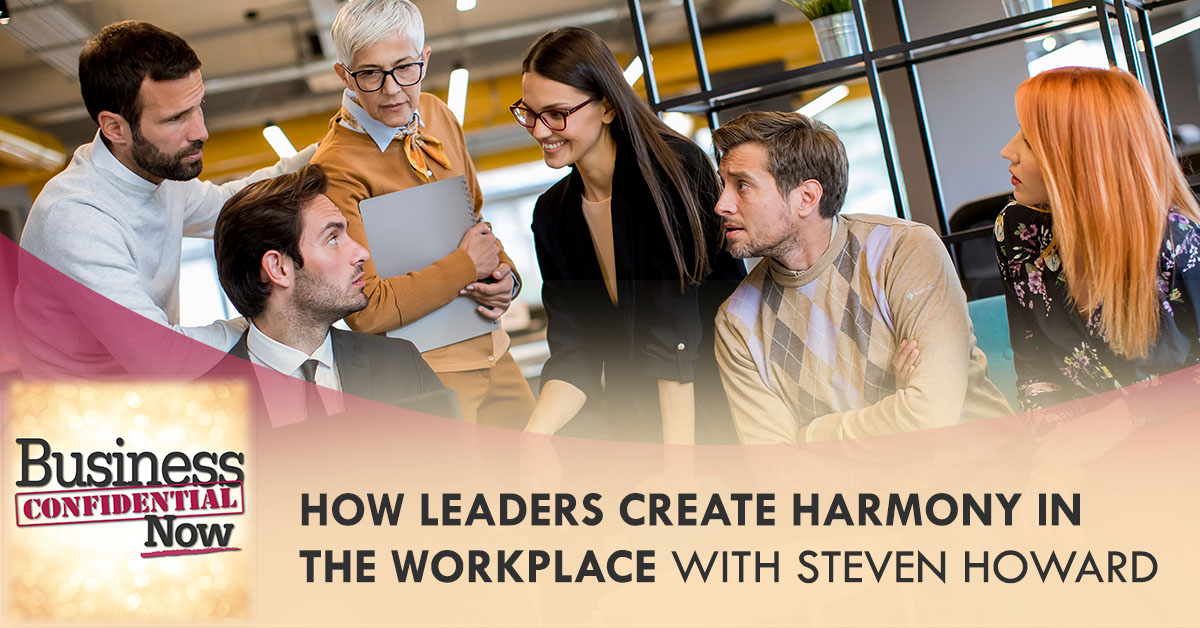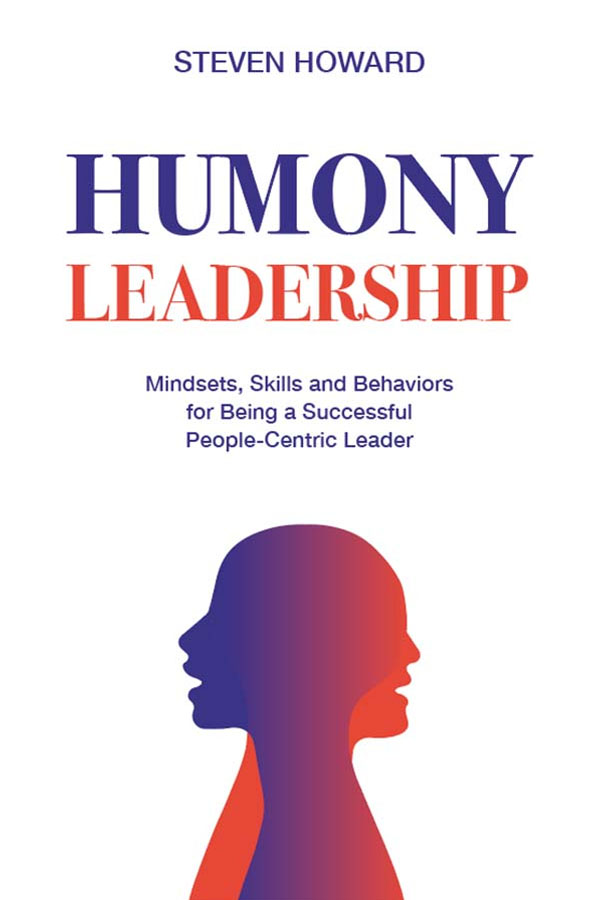
Photo Credit: © iStock | boggy22
This fast-paced world has made it increasingly difficult to have our personal life taken care of while drowning in our work life. As such, we almost always hear advice that calls for “work-life balance.” However, our guest in this episode believes that there is no such thing. Instead, we need to look for “work-life harmony.” Steven Howard sits down with host Hanna Hasl-Kelchner to tell us all about this while taking us into his upcoming book that emphasizes the need for leaders to create a workplace of well-being and harmony. At a time when most collaboration is forced and toxic workplaces drive talent out, we need harmony more than ever. Join Steve as he shares more about getting harmony in the workplace and how this impacts our overall life.
—
What You’ll Discover About Achieving Harmony In The Workplace
- The difference between forced collaboration and cooperatively collaborating
- The bottlenecks to getting harmony in the workplace
- The important role of leadership to shift the course of the organizational culture
- Why emotional intelligence is an important skill for leaders in the future
- Overcoming generational differences in the workplace
- Why innovation and creativity are requirements for organizations today
GUEST
 Steven is the award-winning author of 21 leadership, business, and motivational books and the editor of nine professional and personal development books in the Project You series. His latest book is How Stress and Anxiety Impact Your Decision Making.
Steven is the award-winning author of 21 leadership, business, and motivational books and the editor of nine professional and personal development books in the Project You series. His latest book is How Stress and Anxiety Impact Your Decision Making.
His book Better Decisions. Better Thinking. Better Outcomes. How to go from Mind Full to Mindful Leadership, received a Silver Award from the Nonfiction Authors Association. He also wrote Leadership Lessons from the Volkswagen Saga, which won three prestigious publishing industry awards (2017 Independent Press Award, National Indie Excellence Award, and San Francisco Book Festival Award). He is also the author of Great Leadership Words of Wisdom.
Howard is well-known and recognized for his truly international and multicultural perspective, having lived in the USA for over 30 years, in Singapore for 21 years, and in Australia for 12 years. He currently resides in Southern California.
—
How Leaders Create Harmony In The Workplace With Steven Howard
Harmony in the workplace sounds like something from a Hallmark movie. Nice to have, but really? Isn’t there always someone who’s not pulling their weight or rocking the boat? Our guest says it’s all about leadership. When we come back, he’ll share some tips on how to achieve more harmony in the workplace.
—
In this episode, I’m delighted to welcome back to the show, Steven Howard. Steven is the award-winning author of numerous leadership, business and motivational books who specializes in creating and delivering leadership development curricula for frontline leaders, mid-level leaders and high-potential leaders through his firm Caliente Leadership.
The last time he joined us, we chatted about how stress causes a system overload and impacts your problem-solving. Now, we’re going to talk about his new book that takes an interesting twist on leadership. It’s called Humony Leadership: Mindset, Skills and Behaviors for a Successful People-Centric Leader. Humony is a word he’s coined that he says combines humanity and harmony to emphasize the need for leaders to create workplaces of wellbeing and harmony. Let’s find out what we’ve been missing all these years. Welcome back to the show, Steven.
Thank you very much, Hanna. I appreciate you having me back again.
It was good to have you back. What’s up with Humony? When it comes to harmony in the workplace, why did you jam humanity and harmony into one word? What is it?
People scoff with the idea of harmony in the workplace. I talked to people and I asked them, “Do you have any harmony in your workplace?” They laugh at me and go, “What do you mean?” I took the approach of, “Maybe that’s what we need. We need more harmony in our lives.” I don’t believe there’s such a thing as work-life balance in the world nowadays. Let’s look for work-life-harmony. What works for me? What harmonizes my life would be different than you, different than members in the audience. If we can get harmony in our lives, we’ll be a lot better off. Let’s get harmony in our lives and harmony in the workplace.
People leave bosses, not just organizations. Share on X
Some people might think, “That means having some music on.” How do we achieve that?
I’m going to visualize a Hallmark film from now on. There’s that black and white film.
You got that image now.
I do have that image. It was locked in my head now all of a sudden. Harmony is if you think about flow, when things are flowing for you individually, things are happening. You lose track of time. Everything’s in sync together. Think about a workplace where a team is in flow. The thing happened. People are innovating. They’re bouncing ideas off of each other. There’s camaraderie. There’s the desire to create something new going forward and that’s what harmony is all about. It’s the ability to collaborate cooperatively. Much of the collaboration in the workforce is forced.
It says, “You, you and you, go form this team together and this is the result I want.” Harmony would be a bit different. It’d be saying, “Who wants to work on this project?” The goal is to create something big vision here and how you do it, how you come up with that, I’m going to leave it up to the team. That would be a harmonized workplace.

Harmony In The Workplace: Unfortunately, in many workplaces today, people reluctantly get put together onto a team and don’t speak up. They don’t share their best thoughts and ideas.
Why do you feel it’s more important to emphasize harmony in the workplace now, especially when more people are working remotely than ever before? It’s not like they’re huddled around the conference table as much.
I think you can harmonize even with remote workers. People still have to collaborate even when they’re working remotely or in a hybrid situation or anything like that. If you leave it like it is, people ignore emails, ignore the request to do something, pretend they’re busy, won’t respond to an email. They’ll show up at a team meeting online, sit quietly, and hope nobody bothers them. That’s not going to do anybody good. People are looking for more in life these days and more purpose.
If he had an operation, a team working functioning on all cylinders, so to speak, I think people would be more willing to jump in and participate and collaborate and share their ideas. What happens, unfortunately, in many workplaces is people reluctantly get put together onto a team and they don’t speak up. They don’t share their best thoughts. They don’t share their best ideas. They’re afraid of being ridiculed. They’re afraid of being put down or even worse, they’re afraid their boss might steal the best idea and claim it for themselves. We need to change our attitudes about functioning in the workplace. Harmony is a good word for it.
I agree that harmony is a lovely word, but you put your finger on 3 or 4 hot buttons in that last comment that you made about the reason people aren’t sharing and fear that the boss is going to steal their idea and so on and so forth. How do we break this bottleneck and get more harmony in the workplace?
That’s why the book is called Humony Leadership and it starts with leadership, but leaders have to change their attitudes. One attitude that I say this frequently now is that managing people is a 1980s construct. It’s no longer applicable now. It’s no longer relevant in the world nowadays. It’s like people leave bosses, not just organizations. Nobody wakes up in the morning and wants to be managed by their boss, particularly micromanaged. They want to be led. They want to be motivated. They want to be inspired.
Managers or leaders need to unlearn management and relearn how to be human and treat people as human beings in the workplace. Share on X
As I often say, my favorite philosopher is Yoda. Yoda says, “We have to unlearn what we’ve learned.” I say that managers or leaders need to unlearn management and relearn how to be human and treat people as human beings in the workplace. People are not employees. They’re not workers. They’re not assets. They’re not human resources. They’re human beings. If leaders would treat them like that, then you’re going to get innovation. You’re going to get cooperation from people because you’re treating them as human beings. That’s why the word Humony combined human, humanity and harmony.
What do we need to unlearn, Yoda?
Unlearn management. You manage things. You manage processes, policies, procedures and projects, but you don’t manage people. You lead people and that’s a mindset change. It’s a very important mindset change that leaders have to get their heads around, quite frankly. If they do, then they’re going to be better off. If they don’t, if they revert to the way people have been leading for the last 15-20 years, then you’re going to see people not participating. You’re going to see more people starting their own companies. People are dropping out of the workforce. People decide that it’s not worth it. “I’m not going back to a toxic workplace where I have a boss who bullies me, where I have peers who ridiculed me and laughed at my ideas. It’s not worth it anymore.
It is a mindset change. Part of that mindset change is the realization that the war for talent is over and, frankly, talent, one, people have too many options. As you say, so many people work from home. I read a report the other day that 40% of people looking for jobs in today’s environment are looking for jobs that include at least partial, if not full, working from home or hybrid type solutions. People don’t want to go into a workplace where it’s toxic, where they have problems with their peers and colleagues and no one’s filming each other. That’s why I say we need to bring humanity back into the workplace and we need to bring harmony back into the workplace.
Let’s drill down a little bit more on that, Steven, about harmony in the workplace. What 2 or 3 things specifically could leaders or managers trying to get out of this manage mode? Personally, I think that manager’s and leader’s responsibilities overlap but let’s put it in leadership terms. Two or three things that someone in a position of authority could start doing could shift the course of the organizational culture to promote more harmony in the workplace.

Harmony In The Workplace: Emotional intelligence will be one of the most important skills for leaders and managers going forward.
There are probably 6 or 7 things but if I try to focus on three things that jumped off the top of my mind is be vulnerable. It’s okay to be vulnerable in today’s world. You don’t have to have all the answers as a leader or as a manager. It’s okay to share your concerns to go and say, “I don’t have all the answers. Here’s what I know. Based on what I know, this is the direction we’re going to go.” As soon as we have more information, we may change direction, being open, honest and transparent with people instead of trying to pull the wool over their eyes and combined that with emotional intelligence. I think emotional intelligence is going to be one of the most important skills for leaders and managers going forward.
If I go back 10 or 15 years ago, I know a lot of managers would say to me things along the lines of, “I don’t want to look weak. If I show my emotional side, I’ll appear weak in front of my people.” I don’t think that’s true anymore. That’s a huge mindset change. Probably the third area is to understand that ambiguity and uncertainty are going to be with us for many years to come. We have to plan for uncertainty. We have to plan for ambiguity. That’s why we can’t have all the answers now.
I would suggest that the concept of coaching people now is a concept I call preemptive adaptability. Plan A and plan B won’t work anymore. We have to have plan A, plan B, 1 and 2. Maybe even plan C, 1, 2 and 3 and we will know that if something were to happen, it will trigger plan B two. If something else happens, it will trigger plan C one.
We plan for a change instead of reacting to change going forward. I think those would be the three biggest things that will bring a better workplace, a better working environment where people are able to, again, cooperate and focus together, work together in a direction set by the leaders. I hope that all makes sense. It’s a long answer to a very good question.
I appreciate that. I don’t want to say complicated, but there are lots of nooks and crannies to it, shall we say. You piqued my curiosity about emotional intelligence. Tell me more about what you mean by that because I’m sure there are some people reading that think, “I’m smart. I got this.” What do you mean by that?
If you want to build a sustainable business today or have a sustainable career, you will have to change your leadership style. Share on X
Emotional talent, if you’d go back to Daniel Goleman’s book many years ago, he talks about four aspects. Emotional intelligence is not about controlling your emotions but how you express them. It’s not trying to stop your emotions. We all have the right to our emotions. We all have the right to be angry. Somebody does something in the workplace or in our personal lives and it’s upsetting to us. We have a right to be angry.
Emotional intelligence is how you express that anger. If you turn to somebody and say, “When you say that, it upsets me for this reason or when you say that, it makes me lose confidence in myself, then I get angry with myself for losing that confidence.” That’s one way of expressing your anger. Taking a coffee cup and throwing it across the room or slamming the table or desk and calling somebody an idiot. That’s another way of expressing anger, but I would suggest the first part, intelligence, particularly for the workplace, than the second example there.
That’s the truth as we’re talking about emotional intelligence. It’s interesting that a study of 44 Fortune 500 companies show that even salespeople who had high emotional intelligence produced twice the revenue of those with average or below EQ scores or EQs known for emotional intelligence. Even in a field such as sales, not even leadership but even in sales, emotional intelligence can be quite an asset to have.
In tackling this, you talk about management being this antiquated construct and leaders needing to shift their focus and have a little bit more of a growth mindset and adapting to promote more harmony in the workplace. Out of all of the things that you’ve seen in your experience, what do you think are the most critical problems facing them?
The most critical problem facing now, I think, is leaders are uncomfortable. They don’t know how to change. The big I’m talking about leaders, most leaders in the workplace are either Baby Boomers or Generation X. It’s interesting that the American psychological association calls Generation X the most stressful generation in history.

Harmony In The Workplace: Ambiguity and uncertainty will be with us for many years to come. That’s why we can’t have all the answers today. The concept of coaching people on right now is preemptive adaptability.
Yet they’re the ones who are going to be leading us going forward in the future. We have very stressed-out leaders trying to lead a very stressed-out workforce. I think that that’s one of the key aspects of it. It’s probably what we’ve been talking about here is that so many leaders feel that they have to manage. They have to manage people. They have to overlook them. They have to have their fingers on them at all times. They have to micromanage them, yet that’s not what the workforce wants. Particularly our younger workforce.
They want to be empowered. They want to be challenged. They want to be led. They want to be motivated. Most importantly, they want to grow. They want to grow both professionally and personally. Many organizations in recent years have slashed their training and development budgets to keep their cashflow going.
As a result, it’s only people who are saying, “I don’t want to work at this company anymore. I’m not growing here. This company is not investigating me.” Interestingly, the younger generation is less concerned about titles. I’m a Baby Boomer. People of my generation always want to be promoted. We want to go from assistant manager to manager to senior manager, for instance. Our titles were part of our ego, part of the way we approached the world, so to speak. The younger generation didn’t care about the topic. They want to know that the growing. They’re learning new skills. They’re learning new ways of operating. They’re learning these things better.
Those are the two areas that leaders have to, again, change a little bit. Otherwise, you can still be the old-style leader and be very successful for maybe the next year, 18 months, 2 years, but it won’t last long-term. If you want to build a sustainable business, you want to have a sustainable career. You’re going to have to change your leadership style. That’s one of the key focuses that I talk about in the book. It’s critical for the individual and for the organization to make these changes and to make them rather quickly.
I appreciate that there’s a sense of urgency simply because the different generations like the Boomers are retiring in greater numbers. They’re going to be aging out as a fact of life. Other workforce cohorts will have different needs and different requirements. Whether they’re Boomers in senior management or Gen X in senior management, what is it going to take to get them to change their mindset when for decades, they built careers on being a certain way? Now all of that’s going to be thrown out the window because, “We want to do it this way.” I’m being a little facetious here and realize that, but I want to push you on this point because changing habits is hard for people. What’s in it for them besides, “This is going to be a wonderful Hallmark ending?”
Outdated ways of working result in two things: lack of goal achievement and higher employee attrition. Share on X
What’s in it for them will be their careers. I say that in the book. Even if you’re a leader in the organization where your organization doesn’t change if you change and this is evolutionary, no one’s going to read the book and change in 30 days after reading the book. As they read the book or more people get exposed to this concept, even if you’re a department head and you change your department or even if you’re a team leader and you change your team, a couple of things are going to happen.
Your employee attrition will be lower than the rest of the organization. The innovation and creativity that happens within the unit that you read will go up and will increase. That extremely important requirement for organizations is innovation and creativity. As a result, you’ll be identified either within your organization as strong leader or quite honestly, you need the identified by the workplace as a strong leader and you’re going to get on it.
The organizations, are leaders doing this? Unfortunately, not. They are going to lose the workforce, the employees, but they’re also going to lose their strong leaders if the organization doesn’t change as well. There are a lot of them that have a call, “What’s in it for me?” For the leaders to make these changes. One will be their short-term results and the second will be the chemistry within the team which produces those results. The third will be, quite honestly, their own career path.
It still sounds like it’s a leap of faith to get them to start doing it before they can reap the benefits.
It will be a leap of faith in some regards. On the other hand, it would also be hard-nosed numbers because, as you see, so many organizations are not meeting the numbers now. People are going to blame the recession. They’re going to blame inflation. There’s always an excuse for why thing results are not being produced. If you sat and read the book, read and understand the concept, and look at it.
A lot of it’s going to be, quite frankly, the way we’re leading people. Here’s the crux of it, Hanna. The survey in 2021 of CEOs from around the world, so that the CEOs themselves feel that 50% of their revenues in five years. Fifty percent of their revenues in 2027 are likely to come from products and services that they do not offer now.
That requires innovation. It’s going to require creativity. It’s going to require adaptation to changing commercial environments and a robust economy. This innovation creativity is not going to be brought forward by artificial intelligence. You’re not going to find it in a metaverse. You’re not going to find it by outdated leadership, mantras and mindset. Only in an empowered and motivated human workforce will create these new products and services in the future.
Quite frankly, being fundamentally human and people-centric as their leader has never been more essential in the workplace because that’s the environment that we’re living in. People are going to realize that when outdated ways of working result in two things. It results in a lack of goal achievement and it results in higher and employee attrition. It will be a leap of faith. No doubt about it, but it can be a leap of faith based on the fact that what I’m doing now as a leader is not working.
In order to achieve all that innovation and get those new products and services, it evidently needs more harmony in the workplace. Thank you, Steven. I appreciate your time. I know I gave you maybe a little hard time, but I think it was important in order to get up a better understanding and a grasp of this concept, why it’s so critical and how the workforce is changing and leadership needs to adapt in order to bring forth the best of the employees that they do have.
I appreciate you putting together Humony, what it means and the steps we can take to achieve it. If you’re reading and you’d like more information about Steven Howard and his impressive body of leadership work, that information can be found at BusinessConfidentialRadio.com. Please be sure to tell your business friends about the show and leave a positive review.
The more you dive into all of our past episodes and follow the show, the more you’ll be able to see issues hiding in plain view that matter to your bottom line. Use those tips and strategies to grow your company and be prosperous. Thanks so much for reading. Have a great day and an even better tomorrow.
Important Links
- Caliente Leadership
- https://www.LinkedIn.com/in/stevenbhoward
- http://www.Twitter.com/StevenBHoward
- https://www.Facebook.com/StevenHowardAuthor
- More Than Just Profits: Putting Stakeholder Capitalism Into Practice With John Feloni – previous episode
- If you liked this interview you might also like these Human Resources episodes
Join, Rate and Review:
Rating and reviewing the show helps us grow our audience and allows us to bring you more of the rich information you need to succeed from our high powered guests. Leave a review at Lovethepodcast.com/BusinessConfidential
Joining the Business Confidential Now family is easy and lets you have instant access to the latest tactics, strategies and tips to make your business more successful.
Follow on your favorite podcast app here as well as on Twitter, Facebook, YouTube, and LinkedIn.
Download ♥ Follow ♥ Listen ♥ Learn ♥ Share ♥ Review ♥ Comment ♥ Enjoy
Ask Questions or Recommend a Topic/ Guest:
- Use our convenient Get in Touch form
- OR e-mail feedback(at)BusinessConfidentialRadio.com
Disclosure:
This post may contain links to products to products on Amazon.com with which I have an affiliate relationship. I may receive commissions or bonuses from your actions on such links, AT NO ADDITIONAL COST TO YOU.
